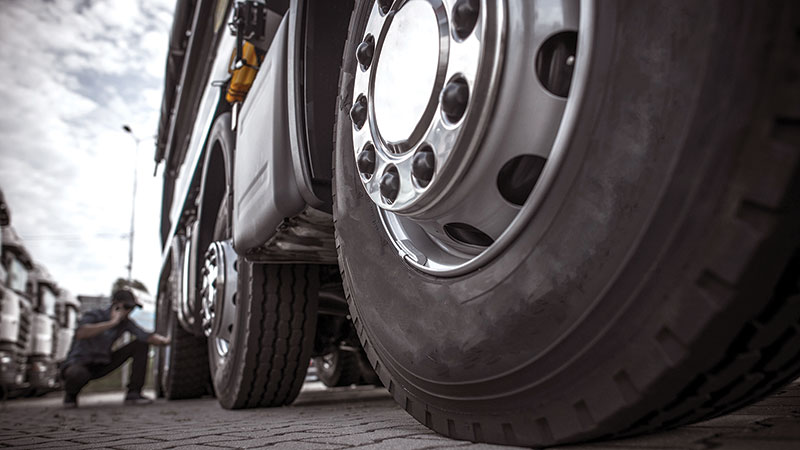While early retread technology left something to be desired, times have changed. Retreads have come a long way since their invention in the early 20th century, and today fleets of all sizes routinely retread the tires on their trucks. They’ve earned their good reputation; retreads are often a more efficient, environmentally friendly, and less costly alternative to purchasing brand new tires.
But as the mercury rises, so does the likelihood of a tire malfunction – or worse, a complete blowout, sending shreds of rubber whipping across the lanes and putting every vehicle on the road in danger. Experts point out that the ‘gators’ and tire scraps you’ll see on the highway are just as often from new tires as they are from retreads: the problem often comes down to improper maintenance, misalignment, overheating, and road hazards – not retreaded rubber. While retreads are generally fit for any terrain or season, ensuring they can hold up in every situation means that any savings you enjoy aren’t compromised by a greater safety risk.
Consider these three key tips to help ensure your drivers’ safety and protect your investment this season.
Do: Ensure your drivers play a role in tire safety
Routine tire checks and better response to road hazards can improve tire performance and safety, but your staff must commit to these steps for your business to benefit. As an owner or manager, you need to effectively communicate the company’s best practices to reduce the risk of tire damage or disintegration. As you compile your training and maintenance strategy, you can incorporate these tips to help drivers prevent tire damage and failure:
• Consider checking your tires more frequently. Proper inflation can both increase performance and extend the life of the tire, allowing it to be retreaded up to three times.
• If you drive through road debris or over rough surfaces, be sure to inspect all tires at your next stop.
• Check tire treads and sidewalls for signs of damage. Look for punctures, excessive scuffing, or misalignment.
• If you find defects, don’t take the risk of driving with a damaged tire – replace the tire as soon as possible.
• Rotate, balance, and align tires periodically to ensure even wear.
• Practice defensive driving by actively scanning the road and safely avoiding hazards.
• Summer weather can be temperamental. When the temperature fluctuates, check tire pressures more often.
Tire safety applies to the workplace, too. Use safety equipment like tire cages to protect staff from undetected hazards (like zipper defects) during tire inflation, educate maintenance workers on how to inspect all tires for defects and damage, and always make sure your equipment is in good working order.
Don’t: Compromise on service
Tires are a huge expense for any trucking company – they’re right up there with fuel and payroll. If you can avoid replacing the entire tire, you should be able to save yourself a good amount of money. Tires can also be retreaded multiple times, translating to an extra 800,000 km of use before they’re spent!1 While the long-term savings associated with retreading can be substantial, consider consulting a tire professional first to decide if it’s the right option for your fleet. For example, legislation prohibits the use of retreaded tires on a bus’s front axle, and it’s generally accepted that they should not be used on the steer axle of any vehicle.
Whether installing, replacing, retreading or repairing tires, you should always use a professional service or reputable supplier. When retreading, it’s crucial that they correctly match the tire to the application to increase fuel efficiency and prolong function. A tire professional will also help you choose an appropriate tire and tread design for current weather conditions.
Do: Invest in expertise
Knowing what to look for and how to fix tire problems can be more difficult than it seems. It makes sense to work with professionals as needed, and raise the bar in the workplace with focused training and education. Frequent monitoring, professional maintenance, and good driving habits will help tires perform safely and efficiently, but won’t make or break your fleet’s safety record or performance standards.
To stay safe and profitable, you’ll have to consider how your retreads can fit into your broader risk management practices. If you’re not sure where to make changes, a consultation from a risk management professional can get you on the right track and help keep your fleet rolling along.
Interested in improving and maintaining your tire safety program? Connect with our Risk Services professionals at www.nbins.com/retreads.
Northbridge Insurance and Northbridge Insurance Logo are trademarks of Northbridge Financial Corporation, licensed by Northbridge General Insurance Corporation
(insurer of Northbridge Insurance policies).
This article is provided for information only and is not a substitute for professional advice. We make no representations or warranties regarding the accuracy or completeness of the information and will not be responsible for any loss arising out of reliance on the information.
About the author:
Bonnie Learn has worked in a variety of roles in the transportation Industry over the past 25 years, and joined Northbridge Insurance as a Risk Services Specialist in 2016.
¹ How retreads help fleets lower their cost and environmental footprint, Bandag. 2017.



